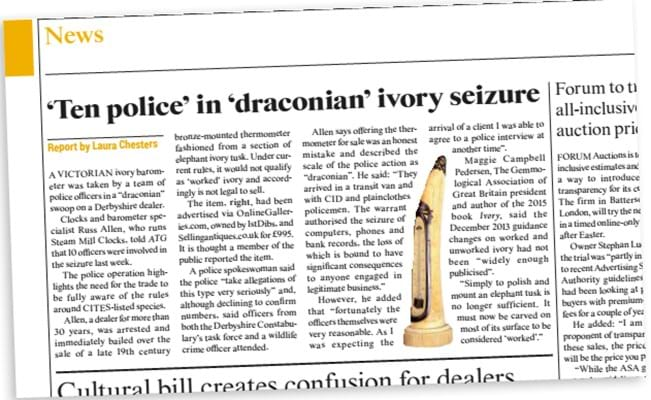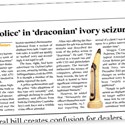Then I find a stunning barometer by Daniel Quare, with ivory column and gilt brass mounts, advertised on page 54 in the same issue, and a perfect ivory-clad tea caddy, advertised on page 11.
Can someone please explain the definition of ‘worked’, as a mounted barometer column seems ‘unworked’ as does the George III caddy!
John J Batty
Arms and armour (consultant) Lyon & Turnbull Auctioneers, Edinburgh
MADAM – Russ Allen, arrested by Derbyshire police for advertising an ivory barometer for sale, which was also confiscated, might wonder why an ivory barometer is advertised in the same issue of ATG and why this has not been confiscated.
I presume the rules are different in the Austrian part of the EU.
Richard Guy
Via email
Editor responds: Our understanding of the case is this: the reason Mr Allen was arrested and his ivory barometer confiscated (see page 4 for an update) is because under the revised CITES definition of ‘worked’ ivory, issued in 2013, whole elephant tusks or sections of tusk where the whole surface has not been fully carved cannot be traded.
The Daniel Quare (1648-1724) portable barometer is a well-known design of c.1700.
Here the mercury tube is contained in a turned and veneered ivory tapering tube formed of three interconnecting sections. As such, the ivory counts as worked and can be sold.
The octagonal ivory-clad tea caddy is also classed as worked.
All three objects are antiques made more than 100 years ago. However, the very different ways CITES authorities regard them does bring into focus the complex nuances of CITES regulations – tackled recently in ATG’s Seminar on CITES – and the ease with which mistakes can be made.
To this end, we remind readers: • That the Worked Item Derogation in EC Regulation 338/97 (865/2006) states: “Worked items that were acquired more than 50 years previously shall mean specimens that were significantly altered from their natural raw state for jewellery, adornment, art, utility, or musical instruments, more than 50 years before the entry into force of this Regulation [before 3 March 1947] and that have been, to the satisfaction of the management authority of the member state concerned, acquired in such conditions.
“Such specimens shall be considered worked only if they are clearly in one of the aforementioned categories and require no further carving, crafting or manufacture to effect their purpose.”
• There is a free, handy guide (pictured above) to worked – including tea caddies – and unworked CITES objects on the ATG website at: antiquestradegazette.com/guides/information-guides/endangeredspecies/












